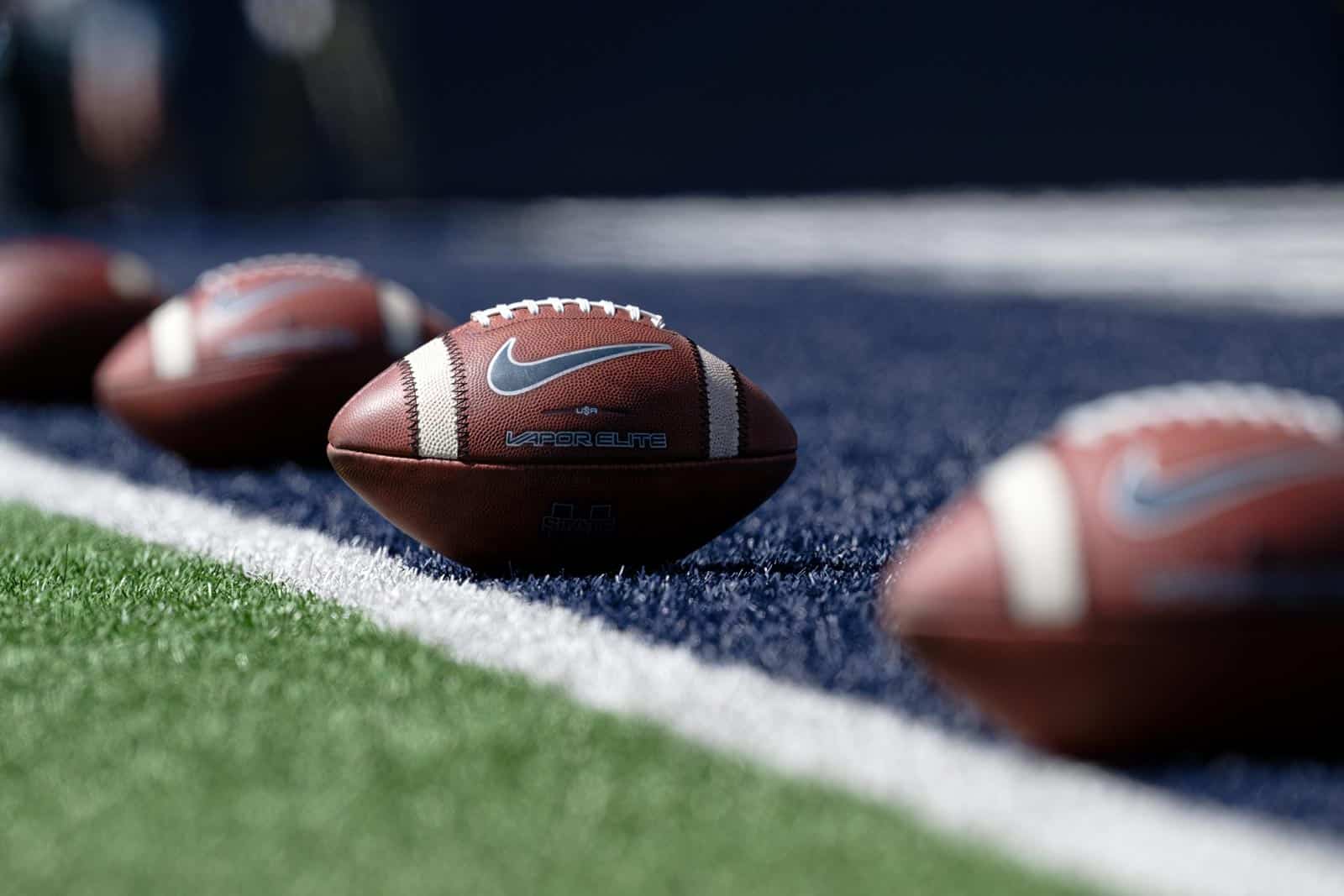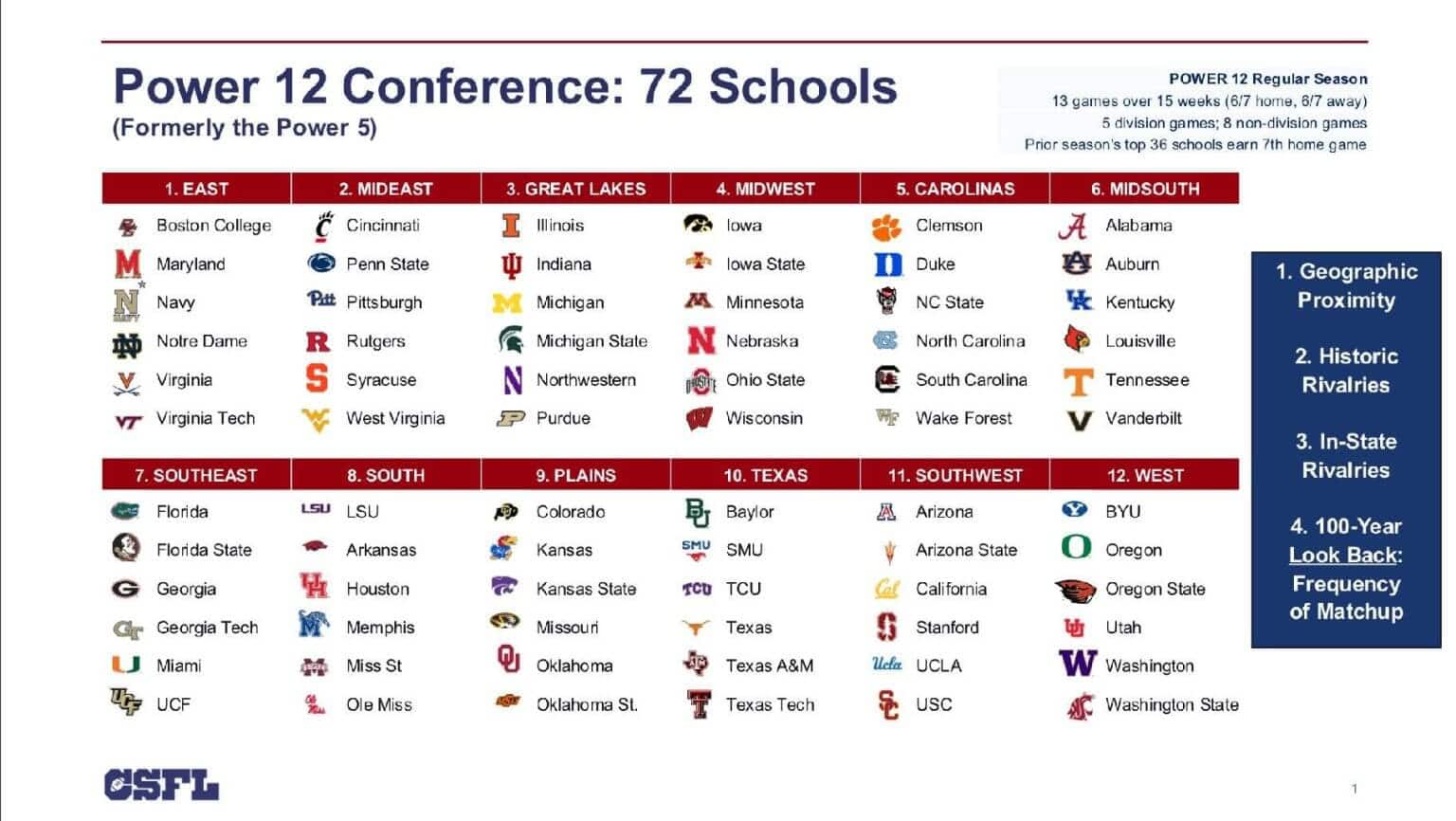College Sports Tomorrow, which is a group of executives and administrators, has proposed streamlining college football into a “Super League” called the College Student Football League (CSFL).
Details of the plan have been in the works for months, but were unveiled by the group on Tuesday. The plan includes the reorganization of the 136 Football Bowl Subdivision (FBS) schools into two conferences. The top 72 programs in the country would compete in the Power 12 Conference, which would be made up of 12 six-team divisions based on geography.
Names of those divisions, based on regions, include East, Mideast, Great Lakes, Midwest, Carolinas, Midsouth, Southeast, South, Plains, Texas, Southwest, and West.
The remaining 64 teams, most of which make up the current Group of 5, would compete in the Group of 8 Conference. Divisions in that conference include East, Mideast, Midwest, Atlantic, Southeast, South, Central, and West.
According to the release, some of the top teams in the Group of 8 would be eligible for promotion to the Power 12 Conference the following season, but there would be no relegation of schools from the Power 12 to the Group of 8.
Below are graphics of the proposed conferences and divisions for each team.
Below are more details on the College Student Football League from the the official release:
The CSFL would apply only to football; other college sports would stay in their current conferences or return to their traditional, geographic conferences, reducing the need for other sports to travel cross-country. The CSFL would include all the current FBS schools in two conferences made up of geography-based divisions. The top 72 programs would compete in the Power 12 Conference with the remaining 64 schools facing off in a second conference, the Group of 8. The best eight schools in the Group of 8 would have the opportunity to “play up” into the upper tier the following season, enabling promotion without “relegation” of any of the Power 12 schools.
Centralized, results-based league scheduling, including non-division games played between schools with similar records from the prior season, would ensure more competitive matchups and allow more schools to stay in the hunt deeper into the season. It would also allow results on the field, not a committee, to determine playoff participation, which in turn would generate more fan engagement in more parts of the country all the way through the regular season and postseason. The College Football Playoff (CFP) would be folded into CST’s proposal so a single league could be charged with managing and growing college football at all 130+ FBS schools.
“The CSFL’s format is better for schools, student-athletes, fans and media partners because more schools will be in the hunt for the playoffs well into November, unlike under the current system in which most schools are out by October,” said Jimmy Haslam, longtime University of Tennessee philanthropist and owner of the Cleveland Browns and other sports teams. “Historically, the beauty of college football has been how many schools around the country were competing for the championship. We need to bring college football back to the broad, national model of its golden years in a system which fosters more competitive balance.” said Haslam.
The CSFL model would be economically advantageous and sustainable in the short- and long-term. Consolidating and centralizing college football allows greater revenue to flow into one unified league, enabling universities to fairly compensate players, create reasonable competitive balance, cover rising NIL costs and continue to underwrite other intercollegiate sports that generate less revenue, including women’s sports and the U.S. Olympic program. The CSFL would directly compensate all student-athlete football players, not just the stars, and NIL and transfer portal rules would be the product of collective negotiations between the CSFL and an association representing football student-athletes. The CSFL supports legislation seeking a determination that student-athletes are NOT employees, but through collective bargaining, the CSFL would give players a voice in rules and economics while providing protection from antitrust claims via the “non-statutory labor exemption,” rather than through a formal, legislative antitrust exemption. This approach should provide a permanent solution to the myriad antitrust challenges plaguing college sports.
Although the idea sounds good on paper, it’s very doubtful that this proposal could be implemented anytime soon. Each FBS conference would have to agree on the change, and then there are the existing television contracts, some of which already extend into the early 2030’s.
What do you think? Is the CSFL a good idea and will it eventually become a reality?




Not a Fan of it & very happy way College Football is currently.
Where the heck is Army and Air Force?
C’mon , including UL Monroe and leaving out Tulane . Ridiculous .
Vanderbilt a “power” , ridiculous .
C’mon , UL Monroe in but not Tulane ?
Connecticut ?
Vanderbilt ?
This is THE stupidest thing that I have ever seen in college athletics history! It will never come into fruition! Whoever came up with this idea should be fired from college sports at once! #pathetic #badmove #ignorant
Don’t worry it’s just a dream, hopefully
Sounds like a fantasy to me
Not just no. Hell no.
Boise State is relegated while Purdue, Navy and Vanderbilt are in the ‘power’ conference. What a joke.
Also, how is Navy a ‘power team’ while Army and Air Force are not? (In fact, I don’t see them in either group).
No, this is the rich get richer proposal. No relegation for top league schools is ridiculous. If a team like UCLA sucks they should move down. This is not a good idea period! It’s down right unamerican.
How the hell do they expect promotion to work but have no relegation on the back end to keep the divisions balanced? This makes zero sense.
Zero chance of the B10 and SEC (specifically the powers in those leagues) signing off on this so zero chance of this happening anyway (I notice that it doesn’t respect some major rivalries either).
There’s no point wasting any more time on this.
It’s a great idea but I don’t get the movement up of Group of 8 schools. That would distort the balance between the two leagues. But the bottom line is that this is a long ways away. And yes, where is Army and Air Force in all of this?
Waste of ink and your time.
Too divided…. i